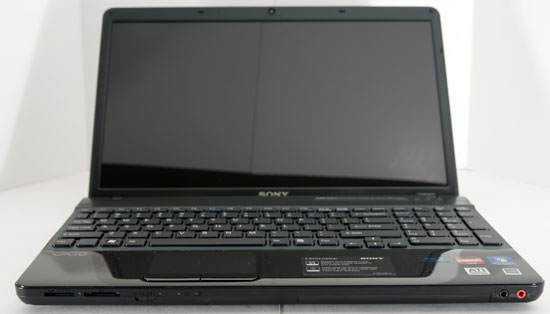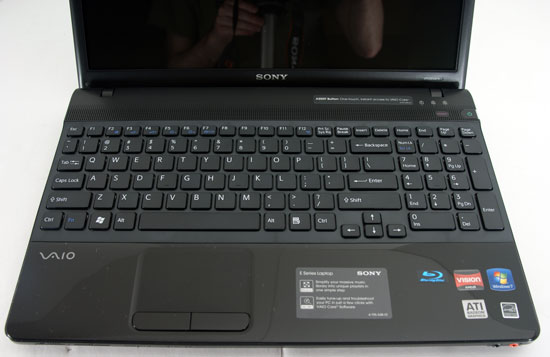Sony EE34: Sony Makes Budget AMD Laptops?
by Dustin Sklavos on February 22, 2011 4:43 PM ESTAn Inexpensive Vaio?
Notice in the headline I didn't use the word "cheap," and there's a reason for that. While there's a decent amount of glossy and matte black plastic and the overall build quality does feel a little more chintzy than some of Sony's more upscale models, as a whole the EE34 doesn't actually feel like a cheap machine.
Writing about the Sony Vaio EE34's looks is going to result in a fairly short review, and that's due largely to the prevalence of black matte plastic all over the build. Sony wisely eschews using glossy plastic on the lid, and though I've found it can still pick up dust it isn't a grease and fingerprint magnet. It thankfully seems like the era of glossy plastic really is finally drawing to a close.

The hinge of the lid allows the screen to tilt back about 135 degrees, allowing for a decent range for finding that sweet spot viewing angle, and the screen bezel itself is thankfully also a matte plastic. At this point only a couple of manufacturers seem to be persisting in putting that gloss where it doesn't belong; most of the others have moved on.
That matte plastic follows down to the inside panelling of the Vaio, through the speaker grille above the chiclet-style keyboard and stopping at the palm rest. Sony has opted to employ glossy plastic for the palm rest, integrated touchpad, and mouse buttons, but at least it kind of makes sense here. Because the gloss is a deep black it doesn't show fingerprints quite as badly as it could, and it's actually fairly attractive. This is probably how glossy plastics should have been used to begin with.

If you're a fan of chiclet-style keyboards you're liable to be at home with the Vaio EE34's. The keyboard has a smart layout that makes full use of the width of the notebook while having minimal flex, and the 10-key is comfortable to use with document navigation keys wisely placed above it. About the only complaint one could reasonably make about Sony's keyboard is that the keys themselves feel a bit on the small side, but most users should be able to get used to them without too much trouble.
The touchpad is textured and is fine for general use, but it's still another perpetrator of one of those cheapest of crimes: being a part of the inside panel instead of being apart from the inside panel. This is something that has very seldom looked good, and while Sony almost pulls it off with the EE34 it still feels like a cut corner. Given the budget nature of this notebook that's something that we can overlook, and the touchpad (and accompanying mouse buttons) has a good enough feel to it that you're not going to be cursing their engineers every time you have to use it.
Upgrading the Vaio EE34 is thankfully not too arduous a task, although a series of little details on the bottom just scream Sony eccentricity. The battery hinges into the notebook in a way that's going to seem unusual; you'd expect it to just slide into the back the way most laptop batteries do, but this one actually has to be inserted at an angle, then canted in and snapped into place. And while the hatch for upgrading the RAM is easy enough to access (single screw, panel pops off), the hard drive bay winds up being sillier than it looks. After unscrewing that panel, you actually have to slide it off instead of just lifting it up. None of these are major problems and they're really only worth mentioning because they're fitfully amusing. If you're used to removing these things in a lot of other notebooks you'll pause for a second and go "wait, what?"
As a whole the EE34 doesn't feel particularly chintzy and at least looks better than a lot of other budget notebooks in its price range. Some users aren't big fans of Sony's designs, but I've always found Vaios to be attractive, stylish notebooks and this one is no different.
















52 Comments
View All Comments
Akv - Wednesday, February 23, 2011 - link
What a bombasticly huge mistake, adding a blu-ray player in a budget laptop...I never buy blu-ray disks, and the only use I have for classic DVD drives is installing software, very rarely.
Silver47 - Tuesday, February 22, 2011 - link
Hi DustinI work on the electrical department in Tescos here in the UK ( sort of our Wall Mart) and we sell the Sony Vaio EE3E which has a similar configuration. It doesn't have the bluray drive and a gig less of RAM all yours for £499 (~$800). When I first saw the spec and pictures I thought how could you not of seen a budget Vaio before, we have had this one for some time (though granted the EE34 is waaaaaay better value to what we have). I would of thought you would of had something like this in the US most of the time?
Anyway heres a pic of the mythical beast http://twitpic.com/42pmjv/full and personally I thought it was one of the better built laptops we have (this is the most expensive one we stock, if you hate crappy displays you'll have a heart attack in here ;) )
Silver
Taft12 - Tuesday, February 22, 2011 - link
Dustin, I think this was one of your best AT articles yet, and it wasn't a very interesting product - I think that speaks well to your improving writing skills.My cousin's wife got a Samsung laptop that was maybe $100 less with no Bluray and the same CPU -- I found myself impressed with the quality of the build compared to low-end Acer and HP, and the battery life was excellent.
I didn't believe it could be true, but the 25W Athlon CPUs really nail the niche they set out to fill - a middle-of-the-road balance between performance and battery life.
GullLars - Tuesday, February 22, 2011 - link
Since you note to begin this laptop has a crappy HDD, i would love to see what potential it holds if you put an SSD in it. Some of us are now moving to our second or third round of SSDs, and may have one left over, or consider purchasing one specifically as an upgrade.Also, this notebook has an 8xx chipset, which means it SHOULD support 6Gbps.
Why not test it with a C300 64GB, and/or the Vertex 3 256GB (a PCmark Vantage run would be more than enough to really put a smile on my face)
mino - Tuesday, February 22, 2011 - link
This was a system review, not a platform review. AMD's mobile platform performance is no secret so fitting even RAMdribe in it is not worth the effort.On the other hand a nice 320G WD Black drive would up the cost about $10 while providing a sensible benefit.
Putting in a basic 80G SSD would destroy its value proposition not to mention even more showing its IGP and CPU bottlenecks.
cfaalm - Wednesday, February 23, 2011 - link
Agreed, just put in the WD320 Scorpio. Even if you buy it afterwards, it would still be a good investement if you also buy a 2.5" external USB housing and place the original Toshiba in there. Nothing goes to waste. I upgraded my 2007 MacBook this way.nitrousoxide - Wednesday, February 23, 2011 - link
I changed both of my laptops with SSDs, and the 2 HDDs put in RAID 0 on my PC. They are slow 5400rpm laptop drives but very fast in RAID :)7Enigma - Friday, February 25, 2011 - link
For some of the early adopters of SSD technology and also for people that upgrade frequently we are just about at the point where some enthusiasts might be on their 2nd or 3rd SSD. That creates the time where some people will have second-hand SSD's from say 1st gen tech (Intel 1st gen or, horror, JMicron 1st gen) and basically do this upgrade for "free".I know not everyone (or even a majority), but there are those out there that have this as a viable option. Me, for instance, has an 80GB second gen (G2) Intel drive that has been fantastic for the last year and a half. More so than needing a speed boost I want to get one for my laptop that I carry around the house (with it's anemic 5400rpm drive).
I could see buying a great 3rd gen SSD for my desktop and migrating the 80GB Intel over to my old laptop, and that is a scenario I see becoming commonplace in the near future.
Just a thought....
jabber - Tuesday, February 22, 2011 - link
Especially a cheap one. If you get 4 years then any laptop has done its job. Time to get a new one thats twice as fast and half the price again.Commodity items. I'd never spend more than £500 on a laptop ever again. Just a tool to use and abuse.
You spend £800+ on a uber laptop and you are always worrying you are going to crack it, scratch it etc.
With a cheap laptop in a ABS type plastic case no worries. The Lenovo G550 series are a prime example of good day to day knock about laptops.
mino - Tuesday, February 22, 2011 - link
I spend $1000 average on a laptop because I need it to work. Daily. And it is cheaper than spending twice $600.Not to mention much more enjoyable working on a not-crappiest LCD/chassis/KB/touchpad/webcam/WAN/BT/Wifi/eSATA/USB3 configuration ...